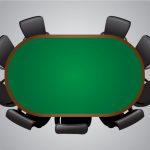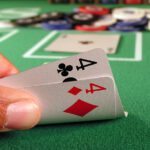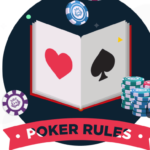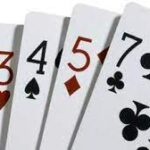After educating yourself on pre-flop strategy, positional awareness, and other basic poker fundamentals, it is time to move onto more complex strategies. One of which is the oldest form of winning a pot, bluffing. There are a few different types of bluffs including semi-bluffs where we bet while on a draw, blocker bluffing where we hold cards that remove nut hands from our opponent’s range, and finally, just regular old bluffing.
Typically a bluff is defined as a bet which can only be called by better hands. This is regularly the case in two-card games such as No-Limit Texas Hold’em but in Omaha our draws can be so strong they actually are ahead of made hands. This is where our first type of bluffing comes into play, semi-bluffing.
Semi Bluffing
In its simplest definition a semi-bluff is a bet with a draw designed to take down the pot. Semi-bluffing is a great way to win pots before showdown without a made hand. It is imperative in PLO to win as many pots as you can without a showdown since equities tend to run quite closely to one another. While there are spots where our draw appears to be strong it can often be difficult to get paid by weak made hands when obvious flush/straight draws come in. Great hands to semi-bluff with are nut draws, for example:
Player A: Ac Jc Td 9h
Player B: Ks Th Ts 5c
Flop: Kc 8c 2h
In this spot, it is going to be quite hard to get paid when we complete our flush, however, we should have little trouble getting our opponent to fold his weak top-pair hand. Looking at the equities in the spot you might find the hands to be a near dead even heat. While this is a great spot to semi-bluff due to having the nut flush draw there are some spots where we might be better off just calling instead of bluffing. This typically comes where we do not have a draw to the nuts but still have quite a good draw. In these spots we do not want to stack off against a better draw. This is why pre-flop decision making is so important. The more disciplined you are before the flop the more aggressively you can play after the flop.
Blocker Bluffing
The rules of Omaha allow for one-card bluffs to be much more effective than in Texas Hold’em. Because players must use two cards from their own hand and only three of the board it becomes easier to pull off naked one card bluffs. The most standard of these blocker bluffs are when we hold the nut card on a three-flush board. For example:
Player A: Ac Kd Ks Th
Player B: 6c 7c 8d 9d
Board: 5c Tc Jc 4h 9d
In this spot we know our opponent cannot have a nut flush. These flops are great to bluff at as players will have a hard time proceeding without a flush or set. We can assume if player B calls both a bet on the flop and turn he will have at the worst a set and at the best a small/medium flush. If we are confident enough in their ability to fold we should certainly consider running this bluff. The bet doesn’t need to be huge, but it should be fairly significant. Here’s another typical blocker bluff:
Player A: Td Th 9c 8s
Player B: Ac Kc Jh 5s
Board: Ah Qd 5c Kd 4h
Here we have an interesting spot. Player A’s hand contains two blockers against the nut straight while Player B has a relatively weak hand. For all Player B knows he could also be behind a set as well as the straight. Having two tens in our hand makes it much more difficult for our opponent to have JTxx in his hand. This should open us up for a nice bluffing opportunity. In this spot we might raise the turn or bet if checked to. From there we will want to fire a nice sized river bet that represents the nut straight. There are other times where we might have three of a kind in our hand, such as Ad9d9c9s that make for even better blocker bluffing, but those tend to be rare situations. Still, if you find yourself in a spot where your cards make it harder for your opponent to have the nuts then taking the aggressive route is certainly a viable option.
Pure Bluffing
This could also be called scare card bluffing because there are spots in PLO where even if we do not hold blockers or a big draw we can still successfully bluff our opponents. This is usually the case when our opponent’s hand range is well defined and obviously weak. There are many situations where this occurs in Omaha and sometimes it takes more than one barrel to get the desired result of a fold.
It would be impossible to go through every typical scenario but there are a lot of times in PLO when we have hands that appear to have showdown value yet have very little. These are typically hands like top pair, bottom two pair, etc… It can take some time to figure out what spots are best to turn your pair hands into bluffs, but you will catch on after checking back the second best hand on scary boards only to see a slightly better hand be shown down.
For example, say we have a hand like pair + straight draw on a two-tone board.
Player A: 6d 7d Jc Tc
Player B: unknown
Board: 4h 5h Ts
Let’s say our opponent bets into us. We can put them on similar draws, two pair, overpair, sets, flush draws, etc. Basically they can have a huge range of hands and with our nut open ender plus top pair we should continue in the hand. Now let’s look at a seemingly meaning turn card:
Board: 4h 5h Ts Kd
This turn gives us less equity but our opponent bets again. What’s great about a straight draw here is it is fairly hidden while the flush draw is always going to be in the forefront of our opponent’s mind. If we happen to hit one of our 6 nut outs (non hard 3 or 8) then we will get looked up fairly light on the river due to the flush draws missing. We can also win when the flush comes in as well.
Note, this play is clearly superior when we have position on our opponent, out of position checking and folding to a turn bet is the proper action of choice. With that in mind, let’s say we have called a turn bet and the river misses our straight but completes the flush draw:
Board: 4h 5h Ts Kd 9h
This is a great spot to bet if/when our opponent checks to us. Typically villains will not have bet weaker flush draws twice and had they had a stronger flush they more than likely would have bet the river themselves. This leaves us up against a lot of hands that all of a sudden aren’t that strong relative to the board and action. Bet sizing is important here. We do not need to full pot the river. The smaller the bet we can get away with, the better. In these cases making a two-thirds or even half-size pot bet can be even more believable than a full pot sized bet. This is because we are representing a wider value betting range which can include most flushes.
The more you play the more you will find spots to make these pure bluffs without blockers. Notice things like your opponent’s river check timing. Did they instantly check the river? If so, a bet is certainly in order as they understand how scary the river card was. Did they bet quite small on a scare card? If so, again, a raise will more than likely work. Remember, if you’re bluffing 2/3 the size of the pot your bluff needs to work to work 40% of the time to break even which means even if your opponent calls every other time you are making money in the long run.
To recap, remember to always have an idea why you are bluffing. You are either doing so with a large amount of equity (semi-bluffing), with blockers, or doing so when scare cards hit the board. If you stick to these basic principles your bluffs should work at a very high rate.
Bluffing In Omaha Poker
Average rating: 0 reviews










